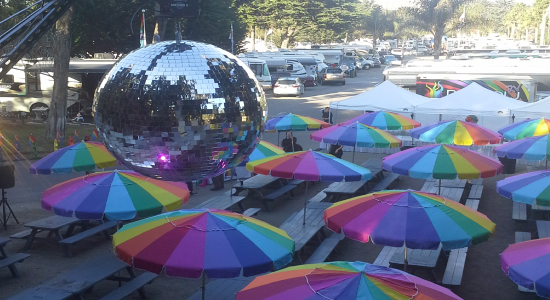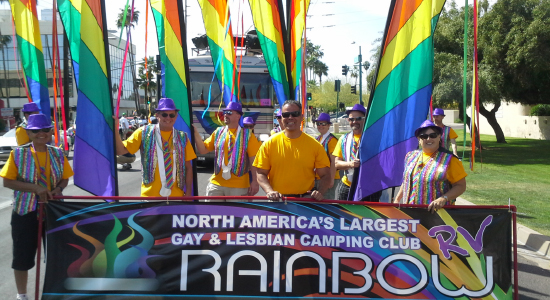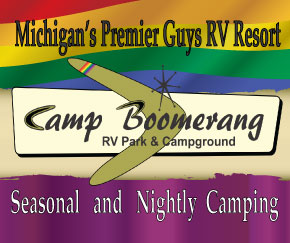| Camping - Campground has 192 sites with electricity
- Each site has a 50-amp electric hookup
- 20 full-service campsites offer sewer and water hookups as well
- Heated shower houses, flush toilets, dump station, a separate beach, boat launching and docking facilities for campers
- 18 sites are wheelchair accessible
- Group camp and horsemen's camp are available
- Pets are permitted on designated sites
Golfing - 18-hole golf course
- Golf pro shop
- Snack bar
- Driving range
- Practice putting green
- Tee time reservations are recommended and can be made online, or by calling 740-432-7185
- Pavilion is available by reservation for outings
Fishing and Hunting - Sizable populations of largemouth bass, crappies, bluegills, walleyes and muskellunge are present
- Fishing is particularly good in the many embayment areas, and along the artificial reef on the north branch of the lake
- Hunting is permitted on designated areas
- Check-in with park or wildlife officers for delineation of these areas
- Cottontail rabbit, gray and fox squirrels, deer, grouse, quail, woodchuck, raccoon, mink, muskrat, beaver, wild turkey and waterfowl are abundant
- An ODNR Division of Wildlife office is located near the main park entrance
Swimming - 2,500-foot beach is one of the largest inland beaches in Ohio
- Modern bathhouse provides showers, lockers, toilets and a snack bar
- Check for water quality advisories
Trails
- Shadebush Trail- Hiking- 2 Miles, Moderate
- Gunn's Glen Trail- Hiking- 2 Miles, Moderate
- Deer Run Trail- Hiking- 1.5 Miles, Moderate
- Overlook Trail- Hiking .1 Miles, Moderate
- Sunshine Brook Nature Trail- Hiking .7 Miles, Moderate
- Forest Crest Nature Trail- Hiking- .3 Miles, Moderate
- Valley Brook Loop Trail- Hiking- .1 Miles, Easy
- Hillcrest Trail- Hiking- 1 Mile, Moderate
- Beach Point Trail- Hiking- 1 Mile, Moderate
- Stone House Loop Trail- Hiking- 1.8 Miles, Moderate
- Morgans Knob Loop Trail- Hiking- .8 Miles, Moderate
- Pine Crest Loop Trail- Hiking- 1 Mile, Moderate
- Hosak's Cave Trail- Hiking- .5 Miles, Moderate
- Snowmobile- 19 Miles, Moderate
- Archery Trail- Hiking 1 Mile, Easy
- Bridle- 12 Miles, Moderate
Picnicking - 9 picnic areas with tables and grills available in scenic locations around the lake
- Wheelchair accessible picnic area with hard surfaced paths and accessible latrines, parking and tables is located off Park Road 1
Lodge - Salt Fork Lodge, scenically overlooking the lake, has 148 guest rooms.
- Lodge features include a dining room, coffee shop, snack bar, gift shop, lounge and lobby areas, indoor game area and meeting rooms accommodating up to 450 people.
- Lodge and cottage guests can enjoy indoor and outdoor swimming pools, sauna, the tennis, volleyball, basketball, and shuffleboard courts, 400-foot swimming beach, as well as boat launching and docking facilities.
Cottages - 37 two-bedroom vacation cottages in hillside and lakeside locations offer fully furnished living and dining areas, kitchen equipped with cooking and eating utensils, bath with shower, and screened porch.
- 17 chalet cottages also feature gas log fireplaces and hot tubs.
- All cottages are available year-round.
- Pets are permitted in select cottages, call 800-282-7275 for details.
Boating - Boats with unlimited horsepower are permitted on the lake
- Combined speed/ski zones are marked by buoys
- There are 10 boat launching ramps on the lake
- Boaters may camp on their boats in no-wake zones within fifty yards of shore
- Swimming from boats is permitted in designated areas only
Marinas - 2 marinas include 469 rental docks, comfort stations, gasoline fuel stations, parking facilities, concession areas and a variety of rental boats
More To Do - A miniature golf course is offered at the beach, near the park's nature center
- Basketball courts are located at the beach and near the park office
- Playgrounds are offered in the campground and at the beach
Area Attractions - History buffs will enjoy Roscoe Village in Coshocton, a restored early 1800s canal town featuring a number of historic buildings and special activities.
- Shoenbrunn Village State Memorial in New Philadelphia depicts the lifestyle of pioneers on the Ohio Frontier.
- Guernsey County Museum in Cambridge is open in the summer.
- Guernsey County is also home to many glass factories and potteries which offer tours and gift shops.
- Not far from Salt Fork State Park are several of the Muskingum Watershed Conservancy District lakes, which offer fishing, sailing, waterskiing and other exciting outdoor activities.
- Wolf Run State Park in Noble County offers a quiet retreat with rustic camping facilities.
- Visit the Cambridge and Guernsey County Convention and Visitors Bureau website at www.visitguernseycounty.com for more information on area attractions.
Nature of the Area Before settlement, Ohio lay in the heart of a vast forest wilderness stretching from the Appalachian Mountains to the Great Plains. None of the world's hardwood forests surpassed this one in variety and size of trees. Ohio's forest was a magnificent sight and an enormous challenge for settlers determined to clear and till the land. Towering oaks, hickories, beeches, maples, walnuts, ashes and chestnuts, some over 150 feet tall, rose from the rich fertile soil below. By 1900, most of Ohio's original forest was decimated. In its place stood wheat, corn, oats, hay and thriving cities. Through conservation efforts over the past few decades, a magnificent regrowth has occurred. Today, nearly 30 percent of the state is once again supporting a thriving forest. This is most evident in the rugged, unglaciated hill region of southeastern Ohio including Salt Fork State Park. Salt Fork contains a blend of rich woodlands and rolling meadows. The park contains diverse populations of plant and animal life. White-tailed deer, wild turkey, ruffed grouse, red fox, gray squirrels and barred owls are well established within Salt Fork. Songbirds such as the scarlet tanager, cardinal, goldfinch, Kentucky warbler and others provide delight for birdwatchers. Spectacular wildflowers such as wild geranium, large-flowered trillium, violets, asters and goldenrod line the forest floor and meadows. In spring, the melody of wood frogs, chorus frogs and spring peepers echo through the park. History of the Area Salt Fork is said to have derived its name from a salt well used by Native Americans which was located near the southeastern corner of the park. Historically, this part of southeastern Ohio was one of the first areas of the state to be settled by the pioneers emigrating westward from the crowded eastern seaboard. Some of these settlers may have followed Zane's Trace into the Ohio wilderness -- a route that led a few families into the Guernsey County area. From Zanesville east to the Ohio River, the Trace became part of the National Road, a major east-west transportation route constructed in 1811. Today, the old National Road is known as U.S. Route 40 and passes near Salt Fork State Park. One of the early residents of Guernsey County, David B. Kennedy, constructed a beautiful stone house overlooking Sugar Tree Fork in 1837. Built from locally-quarried stone cut into 3' x 1' x 1' blocks, the Kennedy Stone House is a sturdy reminder of bygone days. Because of its unique and enduring construction, the house is listed in the National Register of Historic places and can be visited throughout the year. While the southeastern U.S. was the most important staging area for many Civil War battles, southeastern Ohio saw a few skirmishes, too. Morgan's Raiders, a small group of Confederate soldiers, made excursions into the Salt Fork area under constant pursuit from Union Troops led by General Shakelford. As the 19th Century progressed, industry continued to develop in Ohio, and many of the southeastern Ohio counties came into prominence as coal-producing areas. Responding to the demand for this important fuel source, Guernsey County became one of Ohio's leading coal producers. Abundant reserves of clay allowed the development of a thriving pottery industry in the county as well. The present impoundment at Salt Fork dates back to 1956 when planning for the lake was begun. The reservoir was originally slated to become a water source for the city of Cambridge, but the potential for the area to become a major recreation area in the state was so great that, in 1960, land acquisition was begun to create a state park. The earthen dam was completed in 1967, and construction of recreational facilities began in mid 1968. The spacious Salt Fork Lodge was opened in May 1972. |






